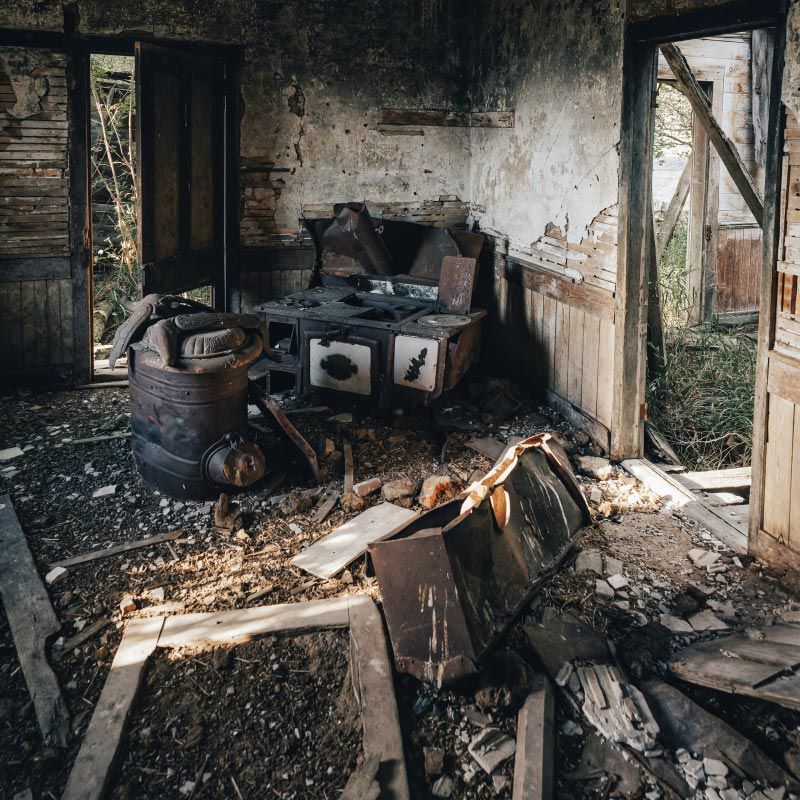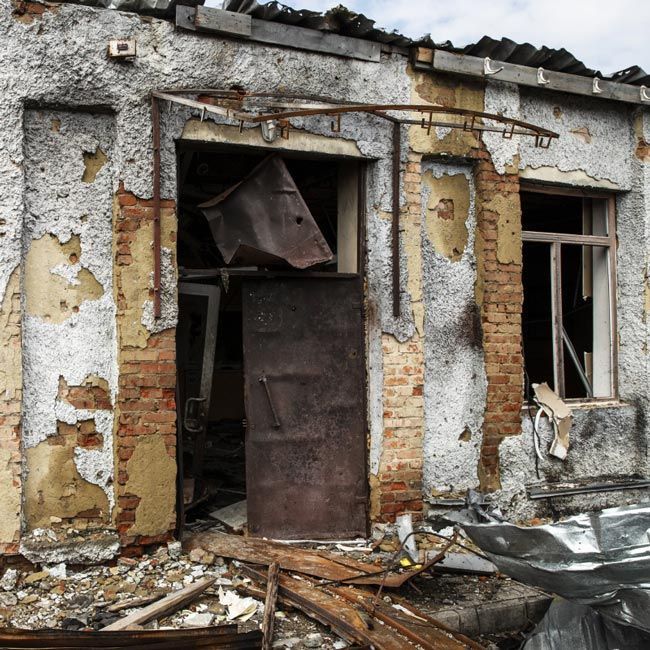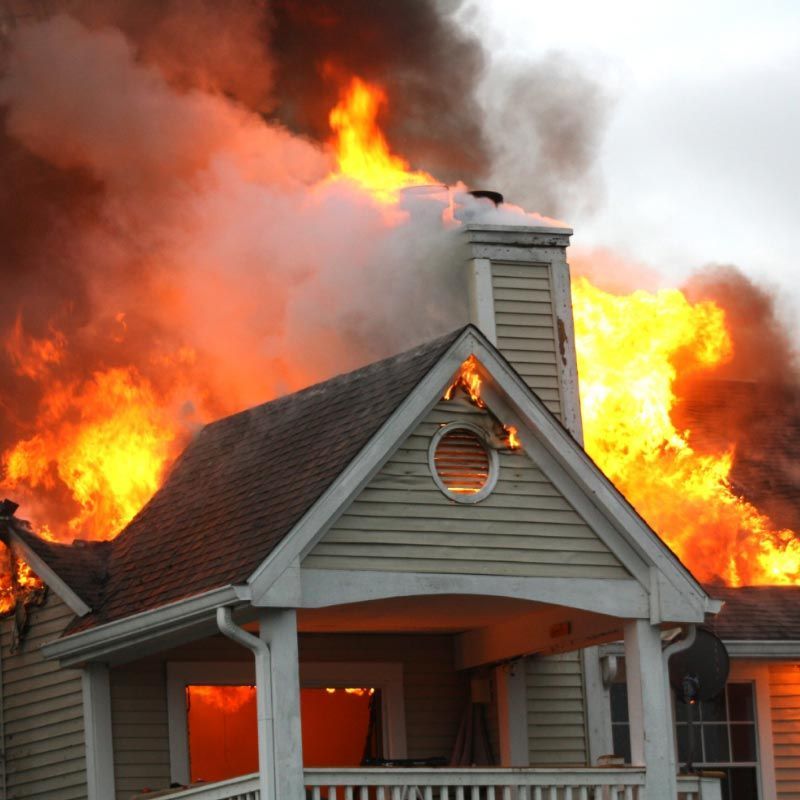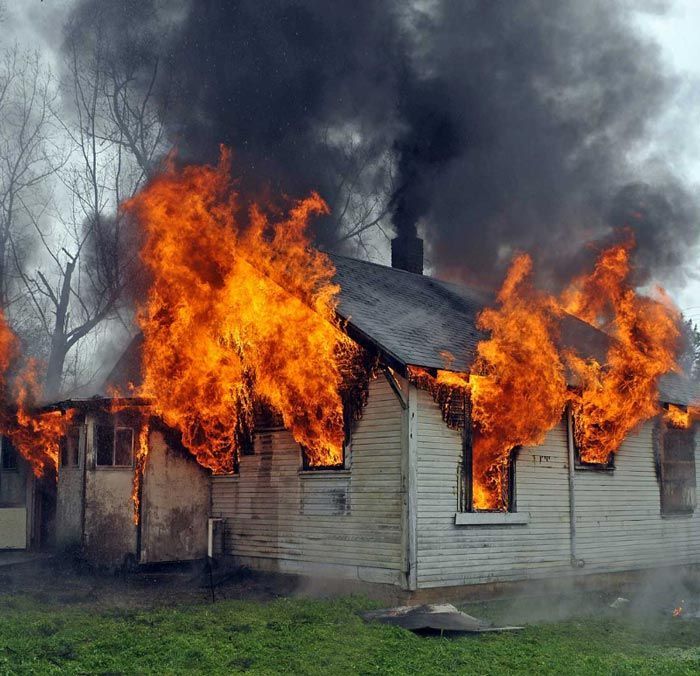When Can You Return Home After a House Fire - Timeline
Free Offer Form
We will get back to you as soon as possible.
Please try again later.
Selling a fire damaged house is possible, though may be difficult with a real estate agent. Selling as-is to a National cash buyer is one of the best options. Fill out the form below to get started and find out what your property is worth.
The aftermath of a house fire is a devastating and disorienting experience that can leave families grappling with uncertainty and emotional upheaval.
Beyond the immediate shock and loss, the burning question on every homeowner's mind is, "When can you move back in after a house fire?"
This complete guide will cover the post-fire recovery process, emphasizing the importance of safety measures and preventive strategies.
Understanding the necessary steps and precautions is crucial for ensuring the safety of yourself and your loved ones and protecting your personal property inside from future fire hazards.
Evaluating the Impact of Fire
This section explores how to assess a fire's impact and the different types of damage it can cause.
Types of Fire Damage
Understanding the types of minor and major damage will help you get through the recovery process and how to proceed after the blaze.
Smoke Damage
Fires often cause smoke damage, entering structures and affecting personal belongings like car keys, medical records, and birth certificates.
Smoke can seep into household items, walls, furniture, and personal items, leaving potentially hazardous residue. This damage needs to be addressed swiftly to avoid health risks from smoke inhalation.
Soot Damage
Soot damage, a common but often overlooked form of devastation, occurs when fire materials release fine smoke particles into the air, compromising indoor air quality and posing health risks.
Structural Damage
In addition to the health threats associated with smoke inhalation, carbon monoxide exposure, and other problems, your own home may have structural damage that renders it unfit for human habitation.
Flames weaken structural integrity and severely harm walls, roofs, and floors.
NOTE: A house fire typically reaches temperatures between 100 degrees at eye level and 600 degrees at floor level, which is hot enough to burn your lungs if you breathe it in.
Can I Sell a Fire Damaged House National ?
Yes. You can sell a fire-damaged house. However, it may be harder to sell in the local National real estate market in as-is condition. You would have to make repairs and possibly rebuild most parts of your house before a buyer takes interest in the property. Your best option when selling a fire-damaged house is a cash buyer. They buy burned houses as-is so you don't need to spend money on repairs. They'll handle all the cleanups and renovations for you, however, expect that their offer may be below the cash value of your property.
Assessing the Damage
This section examines how to properly assess damage caused by a fire.
Hiring a Professional Inspector
Contact your homeowners' insurance company to learn if your insurance has a provision for a professional inspector or claims adjuster.
Professionals can provide a thorough evaluation of your home's damages. They may even send their own fire investigator to the scene.
They identify hidden damage, safety hazards, and property conditions, assisting in insurance claims from your homeowners' insurance company or insurance carrier and ensuring compensation.
You might want a friend or family member present to help you process the trauma the fire caused.
Understanding the Inspection Report
The inspection report is crucial for assessing fire damage, planning repairs, and recommending immediate action. It must be submitted to your insurance provider or insurance agent.
It should detail structural issues, electrical and plumbing system damage, hazardous materials, and safety concerns. Keep it, as you'll need it for insurance claims and future reference.
Cleanup and Restoration Process
This section covers the process of cleaning after a fire and restoring a home after a house fire.
Initial Cleanup
The cleanup and fire restoration process after a house fire involves a multi-phase approach. First, secure temporary housing, as accommodations will be one of your immediate needs after the fire.
Next, the initial cleanup. This step is crucial to ensure safety and prevent further damage and involves the following.
- Safety assessment
- Personal property securing
- Proper ventilation
- Water removal
- Debris removal
- Inventory and salvage
- Documentation for your insurance company
- Professional assistance
- Open communication with the insurance company/insurance provider
The process begins with ensuring property safety, assessing fire damage, and preventing further harm.
Fortunately, the repairs may be swift if it was a small house fire. Small fires can be repaired quickly, especially if it only affects one room.
Professional Restoration
The next step is to contact an experienced fire restoration company to rebuild your house.
Smoke and Soot Removal
The fire restoration company will evaluate the degree of fire damage and help you clean your house. Be present during the evaluation so you can look for any salvageable personal belongings.
Detailed documentation of the process is crucial for the homeowners' insurance claim and future reference. It will be needed by your insurance company later on.
The restoration company utilizes advanced equipment and training to effectively remove smoke and soot residues, improve air quality, and eliminate odors, enabling most homeowners to regain normalcy post-fire.
Structural Repair and Restoration
Professional restoration is crucial after a house fire since you'll need to begin reconstructing the damaged house and other structural repairs, including the following.
- A structural assessment
- Safety measures
- Foundation repair
- Structural reinforcement
- Floor and roof damage repairs
- Wall reconstruction
- Electrical and plumbing systems
- HVAC system restoration
Structural engineers, architects, and other experts from the restoration company will evaluate the extent of the smoke and fire damage, identify compromised elements, and take immediate action.
The Process of Selling Fire Damaged Property to a Cash Buyer
The process of getting a cash offer for a burned house is pretty much the same as any property type. However, it is best if you can contact your home insurance company first before getting an offer for your house after a fire. Your National home insurance company can help assess the extent of the fire damage as well as the repair costs. This can help you decide whether selling a house as-is to a cash buyer is really the right path to take. Once you have decided that you really want to get a cash offer, here are the next steps you should take.
Important note: This doesn't apply to all cash buying companies.
1. Request a Cash Offer
You can easily find cash buyers in your National area by searching online. Once you found a reputable cash buyer, head over to their website to fill out a form or give them a call to ask for a cash offer. Most cash buyers and real estate investors give no-obligation cash offers so you can still ask other cash buying companies how much they can buy your fire-damaged property. If you are unsure about the background of a cash buyer, you can always ask them for proof of their source of funds.
2. Welcome the Cash Buyer into Your Home
The cash buyer or real estate investor may want to check your fire-damaged property for the repairs and improvements it needs, especially its roofing, walls, foundation, etc. You won't have to pay for these repairs when selling a National house to them, but experienced home buyers or real estate investors consider repair costs to make an accurate cash offer.
3. Review the Contract and Sign
Once you accept the cash buyer's offer on your fire-damaged home, they would furnish a sales contract and send it to you electronically. You will be given time to go over the terms and ask questions. After everything is settled, sign the contract to make the deal with the National cash home buyer official.
4. Closing
During closing, expect less paperwork since there are no lenders involved. After you have signed the minimal necessary paperwork and the National deed is transferred to the cash buyer's name, you'll get your cash in your bank account. If you aren't confident attending the closing by yourself, bring a real estate attorney with you.
5. Set Your Preferred Day to Move-Out
If the property has minor fire damage and you are still living in it, communicate to the cash home buyer when you want to move out. This is also a good time to ask for a sale-leaseback agreement if you don't have a place to crash on while you are still looking for a new National home.
Timeframe: "How Long After a Fire Can You Move Back In"
This section focuses on the processes, assessments, and restoration efforts of reoccupying the property.
Understanding these factors can help most homeowners navigate the challenges and uncertainties of the post-fire recovery process, leading to a successful return to normalcy.
General Timeframe
The timeframe to re-inhabit your fire-damaged property varies based on various factors, but here are some general guidelines.
- Initial Assessment (1-2 days): After securing temporary housing, an initial assessment is conducted 1-2 days after the fire. The main concern here is to evaluate the extent of the smoke and fire damage.
- Initial Cleanup (1-2 weeks): The initial cleanup phase following the assessment involves securing the property, removing debris, and addressing safety hazards like smoke and fire damage.
- Smoke and Soot Removal (1-4 weeks): Removing smoke and soot residue from surfaces, ductwork, and possessions can take 1-4 weeks, depending on the extent of the smoke damage.
- Structural Repair and Restoration (Several weeks to months): Structural repair and restoration can vary in duration depending on the smoke and fire damage complexity and resource availability.
- Utilities and Systems Restoration (Varies): Utility restoration can occur alongside structural repairs or as a separate phase, depending on the extent of the smoke and fire damage and the availability of skilled professionals.
- Interior Restoration (Several weeks to months): The process of restoring a property's interior can take weeks to months and involves repainting, replacing flooring, and reinstalling fixtures.
- Final Inspection and Safety Checks (1-2 weeks): A final assessment is conducted to ensure the house meets safety and code standards before returning.
- Insurance and Permits (Varies): Timelines may be impacted by the insurance claim processing, obtaining permits, and coordinating with contractors and restoration professionals.
- Personal Belongings (Varies): Moving back is contingent on the condition of your belongings and furnishings, which may necessitate cleaning or restoration.
Factors Influencing the Timeframe
The fire restoration process duration in a fire-damaged property is influenced by various factors, including the timeframe for moving back into the property.
- Extent of Damage: The timeframe will mostly be affected by the severity of the fire and the extent of the property damage. A small or medium-sized fire may require less restoration than a large-scale blaze.
- Safety and Structural Integrity: Ensuring the property is safe for occupancy is paramount. Extensive structural damage or safety hazards may require more time.
- Specialized Restoration Needs: You may need specialized restoration depending on the type of damage. For example, addressing smoke and soot damage, water damage from firefighting efforts, or hazardous material removal can add time to the process.
- Drying and Decontamination: Water damage and lingering contaminants like smoke and soot must be addressed before the property can be reinhabited.
Coordination and Planning: Effective coordination among various professionals, including contractors, electricians, plumbers, and inspectors, guarantees a smooth and efficient restoration process.
Role of Professionals in Deciding the Move-in Time
Professionals and the property owner all play a crucial role in assessing the safety and readiness of the premises when deciding when to move back in.
- Fire Department Officials: The local fire department assesses property safety, extinguishes house fires, identifies hazards, and may condemn unsafe properties, determining when to re-enter. The fire department should ensure property security by installing security measures such as installing 'do not enter' signs.
- Professional Inspectors: Professional inspectors assess extensive damage, safety, and structural integrity after house fires occur, providing detailed recommendations for re-entry.
- Restoration Contractors: Restoration contractors manage cleanup and restoration, make structural repairs, and restore the house.
- Health and Safety Inspectors: Inspectors evaluate indoor air quality and safety concerns, assessing direct damage or risks of smoke, soot, and contaminants, and may recommend measures like duct cleaning and air quality testing.
- Electricians and Plumbers: Professionals inspect and repair electrical and plumbing systems to ensure safety and prevent a large fire or small house fires.
- HVAC Technicians: HVAC professionals are responsible for assessing and addressing concerns related to the cleanliness, repair, or replacement of HVAC vents to prevent the circulation of smoke particles or contaminants.
Insurance Adjusters: Contact your insurance company and ask them to send an insurance adjuster to assess the damages and inform you of your homeowners insurance policy coverage.
Precautions Upon Returning Home Post-Fire
This section offers safety measures for homeowners and residents returning to their houses after a fire, including structural concerns, health implications, and emotional challenges.
Immediate Precautions
Homeowners and residents should assess the structural integrity of the entire house, contact professionals for safety assessments, maintain indoor air quality, and address electrical hazards.
After completing repairs and returning to the property, follow up with the post office, update your address, and resume your routine.
Long-Term Precautions to Consider
After a fire, take these precautions to ensure a safe transition back to normalcy.
- Structural assessment
- Monitoring your and your family's health
- Good indoor air quality
- Mold prevention
- Fire safety measures
- Insurance coverage
- Regular maintenance
- Emergency preparedness
- Legal considerations
Ensuring Safety: How Quickly Should You Leave Home During a Fire
This section covers evacuating during fire emergencies to save lives and property.
Evacuation Plan
Develop an effective evacuation plan to ensure your safety during a fire emergency and understand when to leave home quickly. Here is how to prepare for an evacuation.
- Identify potential fire hazards in your house
- Compile a list of emergency contacts and the local disaster relief services, like the American Red Cross or the Salvation Army
- Identify multiple escape routes
- Establish a designated meeting point
- Practice drills
- Install smoke detectors and fire alarms
- Familiarize yourself with emergency services
- Have escape tools
- Sign up for emergency alert systems
- Include provisions for pets
- Ensure everyone knows how to use a mobile phone
- Stay informed about your area's fire conditions through local news, radio, or weather apps
Regular practice drills will help everyone become familiar with the process and minimize panic during an emergency.
NOTE: ALE coverage may pay for certain expenses, including clothing, food, lodging, medical care, personal care products, and boarding for pets. ALE coverage works on a reimbursement basis. If you don't have sufficient funds or credit, your insurance company might be willing to give you an advance payment.
Steps to Follow During a Fire Incident
Prioritize following these necessary steps to take after a fire for you and your loved ones' safety.
- Stay calm and make clear decisions.
- Alert others to the fire immediately and gather your family members.
- Evacuate the building promptly; ensuring your safety is the top priority.
- Check doors for heat. Use your hand to touch the doorknob or crack around the doorframe to determine if it's hot.
- Stay low when opening doors. Feel the doorknob or lower part of the door to check for smoke or fire on the other side.
- Close doors behind you to slow the fire's progress.
- Stay outside. Go to a designated meeting point outside the building to account for all family members or occupants.
- Notify firefighters. Provide the firefighter with relevant information, such as the location of missing individuals or hazardous materials inside the building.
Once safely out of the home, determine whether any residents need medical attention and seek immediate assistance.
Frequently Asked Questions
Still have questions? This FAQ section has more info about returning home and rebuilding a house after a fire.
How Harmful Is the Smell of Smoke After a Fire?
House fires are a serious health risk. Smoke odors from fires can cause permanent damage, respiratory irritation, and other health risks.
Addressing and mitigating smoke is crucial for a safe environment during fire recovery efforts.
Is It Necessary to Hire Professionals for Smoke Cleanup?
Yes, hiring professionals for smoke cleanup after a house fire is necessary. They possess the expertise and equipment to effectively address smoke damage, ensuring a safe cleanup process.
Are There Any Health Risks Associated With Moving Back Into a Soot-Damaged House?
Yes, there are risks associated. Soot and other harmful substances that can cause respiratory irritation are a common health risk. Proper cleaning and property assessment are crucial to mitigate these risks.
Do Most Home Insurance Company Policies Cover Fire Damage Restoration Charges?
Home insurance company policies typically cover fire damage restoration charges, but coverage can vary. Review, communicate, and document damage for a successful claim.
Understanding the implications of fire damage restoration costs is crucial when assessing the adequacy of your homeowners' insurance policy coverage for potential charges.
Is There Any Way to Expedite the Return Process After a House Fire?
To expedite the fire restoration process, work closely with professionals and your insurance company. Provide insurance documentation, obtain permits efficiently, and have a thorough plan to return faster.
Conclusion
House fire recovery involves challenges, emotions, and critical decisions. Safety is paramount, and thorough preparations are essential.
We hope this guide has helped you deal with the complex recovery process after a fire. Resilience and community support are crucial in rebuilding homes.
After a house fire, it's important to look forward so that you can rebuild effectively. With the right preparation, you can return home quickly.
National Resources
- Selling a Fire Damaged House National
- Selling Inherited Property National
- Selling a House in Probate National
- How to Sell a House by Owner National
- How to Sell Rental Property National
- Stop Foreclosure National
- Selling a House during Divorce National
- How to Sell a Hoarder House National
- Can You Sell a Condemned House National?
- Can You Sell a House in Foreclosure National?
- How to Sell Rental Property with Tenants National
- Taxes on Selling a House National
Free Offer Form
We will get back to you as soon as possible.
Please try again later.
Author: Chris Charles
We buy fire damaged houses because we like taking on the challenge and making a win win for sellers looking to sell. We work with our partners nationwide and are experienced in dealing with the city if its already been condemned. Request a cash offer to have a chat with us today.
Sell Fire Damaged House for Cash Quick
Sell Your House Fast, To A Legitimate House Buying Company You Can Count On. ✔️ Free, Easy & ✔️ No Pressure Process. Find Out How We Buy Houses!
Sell Fire Damage House in California
Sell Fire Damaged House in Ohio
Sell Fire Damaged House In North Carolina
Sell Fire Damaged House In Michigan
Sell Fire Damaged House In Massachusetts
Sell Fire Damaged House In Colorado
Sell Fire Damaged House In Minnesota
Sell Fire Damaged House In South Carolina
Sell Fire Damaged House In Alabama
Sell Fire Damaged House In Louisiana
Sell Fire Damaged House In New Hampshire
Sell Fire Damaged House In Maine
Sell Fire Damage House in Texas
Sell Fire Damaged House in Florida
Sell Fire Damaged House In New Jersey
Sell Fire Damaged House In Virginia
Sell Fire Damaged House In Indiana
Sell Fire Damaged House In Kentucky
Sell Fire Damaged House In Oregon
Sell Fire Damaged House In Oklahoma
Sell Fire Damaged House In Connecticut
Sell Fire Damaged House In Utah
Sell Fire Damaged House In Rhode Island
Sell Fire Damaged House In Delaware
Sell Fire Damaged House in Pennsylvania
Sell Fire Damaged House in New York
Sell Fire Damaged House In Washington
Sell Fire Damaged House In Arizona
Sell Fire Damaged House In Missouri
Sell Fire Damaged House In Nevada
Sell Fire Damaged House In Iowa
Sell Fire Damaged House In Arkansas
Sell Fire Damaged House In Mississippi
Sell Fire Damaged House In Kansas
Sell Fire Damaged House In North Dakota
Sell Fire Damaged House In Alaska
Sell Fire Damaged House in Georgia
Sell Fire Damaged House in Illinois
Sell Fire Damaged House In Tennessee
Sell Fire Damaged House In Maryland
Sell Fire Damaged House In Wisconsin
Sell Fire Damaged House In New Mexico
Sell Fire Damaged House In Idaho
Sell Fire Damaged House In Nebraska
Sell Fire Damaged House In West Virginia
Sell Fire Damaged House In Hawaii
Sell Fire Damaged House In Vermont






